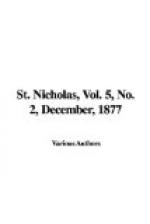“No, this is ‘terra cotta,’ which is Italian for ‘earth cooked.’ Those beautiful lines of color and gilding are painted on the surface.”
“Did you ever see any real antique vases, uncle?” asked Willie.
“Why, certainly. There are some in the Cesnola collection at our Metropolitan Museum of Art in Fourteenth street that are known to have been made 1,400 years before the Christian era. They were found on the island of Cyprus, in the Mediterranean Sea, by General Di Cesnola, who dug up a great many articles,—statues, ornaments of gold, silver and bronze, beautiful glass bottles, and many domestic utensils. I saw a cullender made of such earthenware as we have in the kitchen at this day; it had been used as a milk-strainer, and particles of dried milk were still clinging to its sides, after lying buried more than three thousand years.”
“Oh, we must go and see them!” cried Matie and the boys.
“Yes, you certainly should go,” said their uncle. “You would see some very curious things there, and the elegant forms of many of the articles would show you that a love for beauty has existed almost as long as man has lived.”
“You were thinking of ancient times when you said the history of pottery was almost that of the civilized world; weren’t you, uncle?” asked Will.
[Illustration: JEWELED PORCELAIN.]
“Yes,” answered his uncle, taking from his cabinet a small jug covered with rich gilding, and glistening as if set with precious stones.
“Oh, isn’t that lovely?” cried Matie.
“Well, yes; some people think that this jeweled porcelain, as it is called, is among the choicest of Copeland’s works.”
“Whose, sir?”
“Copeland, of Stoke-upon-Trent, where are some of the largest potteries in England.”
“But don’t you like it, uncle?” asked Matie.
“I do admire it very much, Matie; but not so much as some more simple objects that I have. Here is something that will explain my meaning,” he added, taking from the cabinet a little vase of grayish-brown with darker indented lines drawn in the form of small animals, flowers and foliage.
“Oh, I’ve seen ever so many pieces like that, and I thought they were common stone-ware, the same as the kitchen dishes,” said Al.
“They are of common clay, it is true, but look at the drawing of the figures,” said his uncle, pointing to the tracery upon the surface of the vase.
“Why, yes; it almost seems as if that little rabbit would run away, it is so life-like,” said Willie.
“It was not only for its beauty that I valued this vase, but for the story that it tells,” said Uncle Jack. “In the first place it tells that the simple earth we walk upon can be made by man into works of enduring beauty.”
“Where was that vase made, uncle?” asked Willie.
“At the Doulton Works, Lambeth, England.”
“What is the rest of the story about it?” inquired Al.




